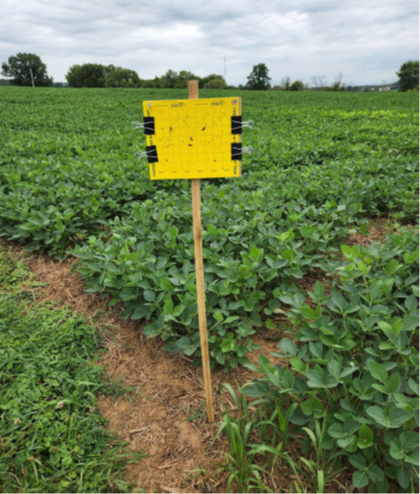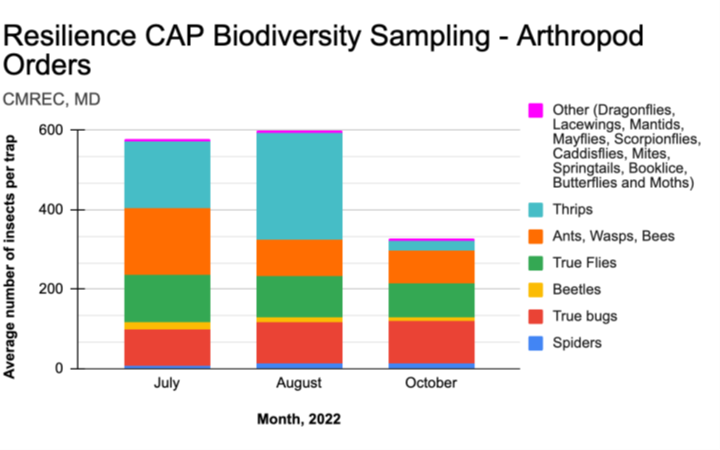Assessment of Ecosystems Services Provided by Arthropods on Farms: Preliminary Use of Sticky Traps to Sample Flying Insects
Helen Craig, Anthony Righter, and Bill Lamp, Department of Entomology, University of Maryland

Background:
Insects are responsible for many ecosystem services, such as pollination, biocontrol, decomposition, nutrient cycling, water filtration, bioturbation, habitat formation, food production, pharmaceuticals, cultural services, and more. It has been calculated that insects have an annual value of at least $70 billion for their ecosystem services (Losey and Vaughan, Bioscience 56 311-323, 2006). However, recent research published in 2017 described an “insect apocalypse” that brought signs of general, unexplained reductions in insect abundance to the public and suggested a catastrophe awaits our planet (Hallmann et al., PLoS One, 12 (2017), p. e0185809). Scientists have long documented the loss of species of insects at a rate exceeding the extinction rates associated with the major geological events in the Earth’s history, but the loss in abundance was surprising to entomologists (currently at a rate of 1-2% loss each year) (Wagner, Annu. Rev. Entomol. 2020. 65:457–80).
As a part of a large nation-wide USDA Resilience CAP grant, we are studying on farm management of plant diversity, crop perenniality, and circular economic systems (DPCS) as potential catalysts for improved ecosystem services, in part by enhancing insect biodiversity. A diverse agroecosystem includes diversity in crops over time, like crop rotations, and space, like intercropping. Perenniality involves including perennial crops such as alfalfa and other crops to provide soil cover and nutrient retention. Circularity in an agroecosystem enables recycling nutrients as opposed to losing them to air or water as pollution (i.e., animal manure). We hypothesize that increasing diversity, perenniality, and/or circularity will improve insect biodiversity and their ecosystem services on farms. Here, we investigated the use of sticky traps to assess the flying insects on farms towards documenting the ecosystem services that DPCS farms can provide. Our goal is to determine if this sampling approach will be useful in our nation-wide assessment of farm insect biodiversity.
Methods
Starting in June, 2022, and continuing through 2023, we used 9x11” yellow sticky traps (see Images 1 and 2) set up in five distinct locations on two University of Maryland farms (Western Maryland Research and Education Center and Central Maryland Research and Education Center-Clarksville). With two traps at each location, the five locations were labeled as center, northwest, northeast, southwest, and southeast. Sticky traps were set out five times during the summer season in May, June, July, August, and September. Each month the traps were left out for one week before collection. Crop, vegetation, and weather data were documented at each collection period. The sticky traps were transported back to the lab for identification, which included the number of arthropods for each family, and their association with the ecosystem services that they provide.

Discussion
Although we have not finished collecting and processing the samples, there is a lot of potential in the data we have collected thus far. Using these data sets, we can compare the different locations on each farm, and their respective crop types, to the number of individuals in various functional groups collected from that area (example in Figure 1) or the composition of insect orders over time (example in Figure 2). This information can provide insight into the types of crops that contribute to a variety of ecosystem services present in an agroecosystem. Over the course of this project we will continue to keep track of the diversity, perenniality, and circularity of each farm’s agroecosystem over time and relate farm characteristics to the ecosystem services provided by the presence of flying insects and other arthropods.
Figure 1. Preliminary biodiversity sampling data showing the average number of individuals per location in June, 2022. NW was near a soybean/alfalfa intercropped field, soybean/rye cover crop field, and a wheat field. NE was near a mixed grass pasture field and a corn field. SW was near a soybean field and a corn field. SE was near a soybean field and cut lawn. Finally CN was near an unmanaged area, a wheat field, and a corn field.

Figure 2. Preliminary arthropod sampling data showing the average number of individuals per trap across 10 traps at CMREC-Clarksville, and 3 sample dates.
